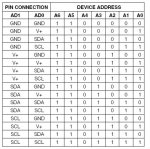Ok I am having a go at driving some seven segment displays with a MAX6955. I amusing it because it uses the i2c bus and is common cathode, it ticks all the boxes I have! Now I have been able to run a SAA1064 chip successfully but it is a new learning curve with the max chip. Below is the adress for the SAA1064 chip, how do I find the address for the max chip? I have looked through the document on the max chip and could not find it (blind in one eye and can't see out the other posibly).
Thanks
Code:
Symbol disp = %01110000 'display address
Symbol dispcode = %01000111 'instruction byte
